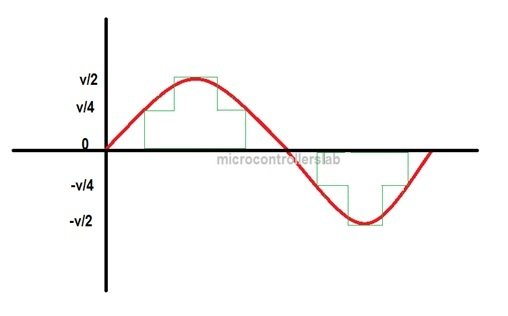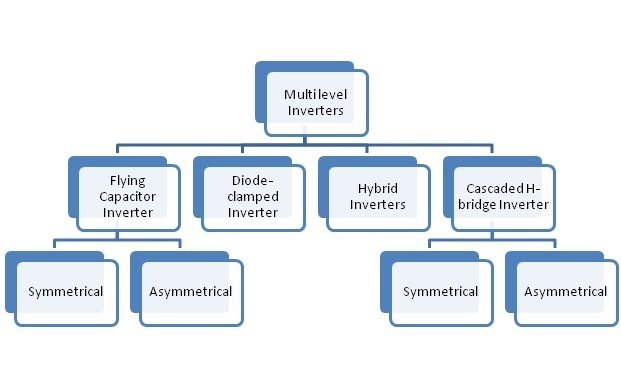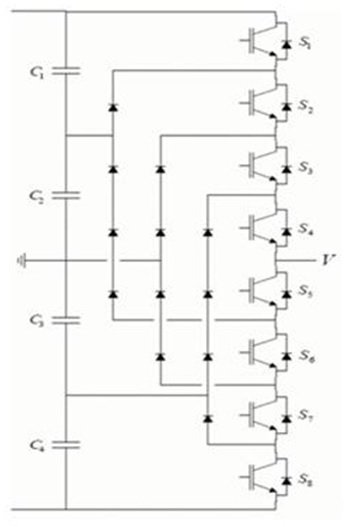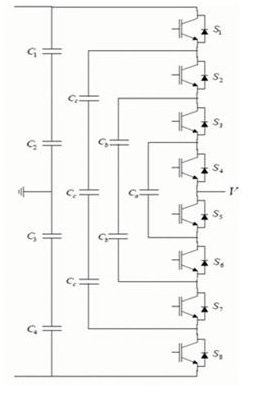This article discusses multilevel inverters, their types, applications, advantages, and disadvantages. In order to have a clear understanding of multi-level inverters, one should have an explicit idea about inverters and their purpose in power electronics.
Introduction
The branch of electronics that deals with the conversion and control of electric power is power electronics. Many of our appliances work with AC voltage, but a power generator normally generates on DC. So, if we want to run something like an AC-powered gadget from a DC car battery in a mobile home, we need a device that can convert DC to AC. This concept generates the need for inverters.
Inverters
The device that converts DC voltage to AC voltage is an inverter. Output voltage should ideally be a sinusoidal wave of variable magnitude and variable frequency. An inverter does the opposite job of a rectifier. Electronic inverters can produce smoothly varying AC output from a DC input. Industrial inverters have capacitors and inductors, which make the output current smoother in comparison to the switching square wave output we get with a basic inverter.
A good example of the use of inverters is in emergency power supplies; we also refer to them as uninterruptible power supplies (UPS). In a typical UPS, when power is flowing normally, the batteries charge with DC. This DC voltage is attainable by converting the AC power supply using a transformer and rectifier circuit. If the power fails, the batteries provide DC through an inverter in order to produce AC.
Multilevel inverters are the choice of industry for high-voltage and high-power applications. Multilevel inverter technology is emerging recently as a very important alternative in the area of high-power, medium-voltage energy control. This article presents the concept behind multi-level inverters, their types, pros and cons, and the area of their practical applications.
Why Multi-level Inverters?
The need for a multilevel converter is to provide high output power from a medium-voltage source. The multi-level inverter consists of several switches.
- The devices with lower ratings can generate higher voltage.
- An increase in the number of voltage levels produces a better voltage waveform..
- The reduction of switching frequency for the PWM operation.
How Multilevel Inverters Works?
The most common type of inverter that generates AC voltage from DC voltage is a two-level inverter. A two-level inverter creates two different voltages for the load, i.e., suppose we are providing V as an input to a two-level inverter, then it will provide +V/2 and -V/2 on output. In order to build an AC voltage, these two newly generated voltages are usually switched.
Although this method of converting voltage is effective, it has some limitations as it causes disturbances in the output voltage. Normally, this method works, but in some applications, it creates problems, specifically where we do not require high distortion in the output voltage.
The concept of a multilevel inverter (MLI) is a kind of modification of a two-level inverter. In multilevel inverters, we don’t deal with the two-level voltages; instead, in order to create a smoother stepped output waveform, more than two voltage levels are combined together. The smoothness of the waveform is directly proportional to the voltage levels; as we increase the voltage level, the waveform becomes smoother, but the complexity increases.
Types of Multilevel Inverters
Diode Clamped Multilevel Inverter
This type of inverter uses diodes and gives different voltage levels to the capacitor banks connected in series. The benefit of using diode is to reduce stress on other electrical devices because it gives a limited amount of voltage. But there is a drawback of this topology that the maximum voltage which we can get from it cannot be more than half of input voltage (DC voltage). But this problem can be solved by increasing the number of capacitors, switches and diodes. This type of inverters provides the high efficiency and it is a simple method of the back to back power transfer systems.Example: 5- Level diode clamped multilevel inverter, 9- level diode clamped multilevel inverter.
Flying Capacitors Multilevel Inverter
The main idea of this topology is the use of capacitors. The capacitors transfer the limited amount of voltage to electrical devices. In this inverter switching states are like in the diode clamped inverter. Clamping diodes are not required in this type of inverters. Likewise, the maximum voltage which we can get from it cannot be more than half of input voltage (DC voltage). It can control both the active and reactive power flow. But due to the high frequency switching, switching losses will takes place.Example: 5-level flying capacitors multilevel inverter, 9-level flying capacitors multilevel inverter.
- This inverter is same like the diode clamp multilevel inverter
- In this inverter we only use switches and capacitors.
Cascaded H-bridge Multilevel inverter
The Cascaded H-bridge multilevel inverter uses capacitor and switches. It requires less number of components in each level as compared to previous described types. This topology consists of series of power conversion cells and power can be easily scaled. The combination of capacitors and switches pair is called an H-bridge. It consists of H-bride cells and each cell can provide three different voltages like zero, positive DC and negative DC voltages. Example: 5-H-Bridge, 9-H-Bridge Multilevel inverter
Advantages
| Diode Clamped Multilevel inverter | Flying Capacitor multilevel inverter | Cascade H-bridge multilevel inverters |
|---|---|---|
| We can use these back to back | Static var for balancing capacitors voltage level, phase redundancies are available | Output voltages levels are doubled |
| Capacitors are pre charged | we can control reactive and real power flow. | the number of sources Easy and quick |
| Efficiency is high at fundamental frequency | Manufacturing Packaging and Layout is modularized. | |
| Capacitance is low | We can control it Easily with a transformer | |
| Inexpensive |
Disadvantages
| Diode Clamped Multilevel inverter | Flying Capacitor multilevel inverter | Cascade H bridge multilevel inverters |
|---|---|---|
| DC level will discharge when control and monitoring are not precise | Voltage control is difficult for all the capacitors | Every H Bridge needs a separate dc source |
| Number of clamping diodes increases with the increase of each level. | Complex startup | Due to large number of sources, Applications are Limited. |
| Static var compensation | Poor Switching efficiency | |
| Capacitors are expansive than diodes |
Applications
| Diode Clamped Multilevel inverter | Flying Capacitor multilevel inverter | Cascade H bridge multilevel inverters |
|---|---|---|
| Variable speed motor drives | Induction motor control. | Motor Drivers |
| High voltage system interconnections | Static var generation. | Active Filters |
| High voltage DC and AC transmission lines | Both AC-DC and DC-AC Conversion applications. | Electric vehicle drives |
| Converters with harmonic distortion capability. | DC power source utilization. | |
| Sinusoidal current rectifiers. | Power factor compensators. | |
| Back to back frequency link systems | ||
| Interfacing with renewable energy resources. |
Conclusion
In conclusion, this article provides an in-depth overview of multilevel inverters. It covers their basic introduction along with types, advantages, disadvantages and applications to help us better understand the concept of inverters. Hopefully this was helpful in expanding your knowledge of inverters.
You may also like to read:
- Pure sine wave inverter circuit diagram
- Pure sine wave inverter using pic microcontroller
- Modified sine wave inverter
- Three phase sine wave inverter using Arduino
- Solar inverter
This concludes today’s article. If you face any issues or difficulties, let us know in the comment section below.









nice information